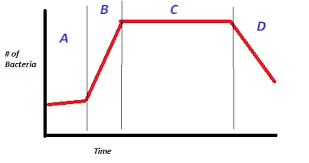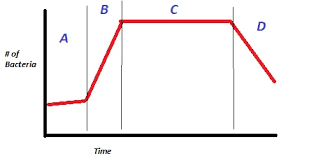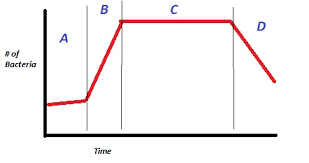CH.7 - Bacterial & Archaeal Growth
1/46
There's no tags or description
Looks like no tags are added yet.
Name | Mastery | Learn | Test | Matching | Spaced |
|---|
No study sessions yet.
47 Terms
binary fission
asexual reproduction in which a cell separates into 2 identical daughter cells; most common mechanism for bacterial cell division
Bacterial and Archaeal Cell Reproduction
1. Elongation of the cell
2. Replication of the chromosome
3. Separation of the chromosomes into two parts of the cell
4. Formation of the septum in the middle (via cytokinesis or septation)
cytokinesis (septation)
process of forming a cross wall between 2 daughter cells during cell division
origin of replication
site where DNA replication is initiated
Penicillin-binding protein (PBP)
group of proteins that hydrolyze bonds in existing peptidoglycan strands and link new strands
NAG and NAM
major components of peptidoglycan that bind to a membrane protein called bactoprenol
Autolysins
degrade polypeptide where new units are to be added, and the new NAM-NAG units can then be inserted into the peptidoglycan layer
Archaeal Cell Reproduction
reminiscent of a miotic cell cycle
coccus shaped
new peptidoglycan forms only at central septum
bacilli shaped
requires the use of elongasome
vibrio shaped
produce a cytoskeleton whose filaments insert new peptidoglycan
batch culture
growth of microorganisms in a closed culture vessel WITHOUT adding fresh or removing old medium

Lag phase (A)
period following the introduction of microorganisms into a fresh culture medium; when there is no increase in number of cells

Exponential Phase (B)
microbial population is growing at a constant and maximum rate, dividing and doubling at regular intervals

Stationary Phase (C)
population growth ceases and growth curve levels off

Death Phase (D)
equilibrium between dying and reproducing cells shifts and the number of viable cells decline exponentially
Long-term stationary phase
population size remains at a more or less constant low level for an extended period
budding
form of asexual reproduction seen in Listeria
Baeocyte formation
multiple rounds of cell division; seen in cyanobacteria
generation time
time it takes a population to double
hypotonic
when the environment has a lower solute concentration than the interior of the cell, the environment is . . .
hypertonic
when the environment has a higher solute concentration than the interior of the cell, the environment is . . .
sessile
microbial cells are attached to a solid substrate
planktonic
free-living microbes
biofilms
organized microbial communities encased in extracellular polymeric substances and associated w/ surfaces
emergent properties
properties of a system that cannot be inferred from the components of the system
quorum sensing
process in which bacteria monitor their own population density by sensing levels of signal molecules released
burst
microorganisms in a hypotonic solution . . .
shrink
microorganisms in a hypertonic solution . . .
osmophiles
microorganisms that grow best in or on media of high concentration solutes
halophile
microorganism that requires high levels of NaCl for growth
osmotolerant
organisms that grow over a fairly wide range of solute concentration
xerotolerant
microorganism that grows best under low water activity
cardinal temperatures
minimum, maximum, and optimum temperatures for growth
psychrotolerant
microorganism that has a growth optimum between 20°C and 30°C; a maximum of ~45°C or lower
psychrophile
microorganism that has an optimum growth temperature of 15°C or lower and a temp. maximum of 20°C
grow well in refrigerated foods
Mesophile
microorganism that grow well in 20°C to 45°C
thermophile
microorganisms that have a growth optimum of 55°C or higher
obligate aerobes
require oxygen for growth and die without it
facultative anaerobes
do not require oxygen to grow, but grow better in its presence
aerotolerant anaerobes
microbes that grow equally well whether or not oxygen is present
obligate anaerobes
microorganisms that cannot tolerate oxygen and die when exposed to it
barotolerant
grow and reproduce at high pressures but do not require them
piezophilic
microorganism that prefer or require high pressure for growth
ionizing radiation
most harmful EM radiation to cells; very short wavelength, but high energy that cause atoms to lose electrons
oligotrophic
environments that have a low supply in nutrients
eutrophic
environments that have a high supply of nutrients